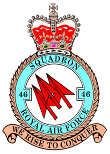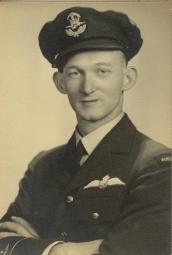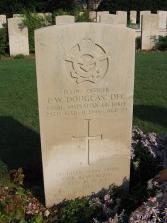|
The Secretary, No. 46 Squadron RFC and RAF Association,
Dear Sir, I write in the hope that you may be able to assist me in my attempts to research the involvement of Frank Douglas in No. 46 Squadron. Below, I have identified Frank, who was my mother’s brother, together with a brief description of his service with the Squadron.
The photo at left was taken soon after Frank received his commission and was promoted to Flying Officer on 19 May 1944. Frank was posted to RAF Stoney Cross on 8 February 1945 and was attached to No. 46 Squadron which had arrived there from North Africa in January 1945. He had previously been a Lancaster pilot with No. 467 Squadron (RAAF) based at Waddington. He was born in Cloncurry, Queensland on 1 Jan 1921 and enlisted under the EAT Scheme in April 1942. At No.3 ITS, Sandgate, Queensland, he completed basic flying training on No. 27 Pilot’s Course (DH82). He moved, on 3 Sep 1942, to No.8 EFTS at Narrandera, New South Wales for initial aircrew training as a pilot flying DH82 and Avro Anson trainer aircraft. On 11 December 1942 he sailed for Canada and underwent further aircrew training on Cessna Crane trainers at No.12 SFTS, Brandon, Manitoba. He arrived at No.11 PDRC on 5 Jun 1943 and was attached to No. 50 Group (Pool). He undertook further advanced aircrew training on Airspeed Oxfords followed by a conversion course to Wellingtons. He flew Wellingtons on operations out of a satellite of RAF Ramsbury in Wiltshire for most of the second half of 1943. During the early months of 1944 he undertook a conversion course (to Lancasters I presume) at 1660 CU. After his discharge as an airman (F/SGT Pilot) and upon receiving his officer’s commission he was attached to No. 467 Squadron at Waddington on 30 Jun 1944. Having completing two tours with 467 Squadron, he was attached to No. 26 OTU on 18 Nov 1944 where he presumably undertook a conversion course to obtain his endorsement to fly Stirlings. On 17 March 1945, a little over a month after his arrival at RAF Stoney Cross he drew an issue of Tropical Kit, presumably in preparation for operations on the Far East Service to India. I have photographs he took in Iraq (Baghdad is annotated on several) and over Tel Aviv. The next entry in his service record was a notification that he was “missing presumed dead” on 24 Mar 1945. The record states that this was a non-operational flight (whatever, that meant with the war in Europe still dragging on). Without the benefit of his Pilot’s Log and any further detail in his service record I am unable to complete an accurate reconstruction of the tragic events of the fatal crash. The record shows that it occurred in the Canigou Mountains of S-W France. Surely there should have been an accident investigation report and some entries regarding his burial. Perhaps there is a record in the Squadron’s Archives. Family oral history attributes poor flying conditions as a cause of the crash. All 14 personnel on board were killed and were buried in the Mazargues CWG Cemetery at Marseilles, France (photo below). He was posthumously awarded the DFC which primarily related to his record as a Lancaster pilot with 467 Squadron. Please note that some inaccuracies may exist in my embellishments of the bare facts taken from Frank’s records. Your advice that may correct any such error or omission would be greatly appreciated.
|
|
Flying Officer Francis William Douglas DFC RAAF |
|
Grave of Fg Off Francis William Douglas at Mazargues CWG, Marseilles, France |
|
Translation of Report a) 24 March 1945 b) RAF Bomber Route: Libya – England c) Short Stirling Mark V, PJ 911, No 46 Squadron, RAF, based at Stoney Cross. d) Pilot: Pilot Officer McMillan was one of three pilots. There were three pilots on board, plus six crew members, i.e. nine airmen. e) The aeroplane was undertaking a training flight from Castel Benito in Libya to Stoney Cross in Hampshire in southern England in loose formation with three other Stirlings, when it crashed into a mountain, while flying below the safety altitude recommended to the crews at the briefing. On 24 March 1945, the visibility was very poor on the Massif XXX. The aircraft was reported missing when they realised that it had not arrived at the Stoney Cross aerodrome. Initially, they thought that it had crashed into the sea, and with good reason … As we will see, the aeroplane had struck the foothills of XXX at 2456 metres in the department of Pyrénées-Orientales. The story that follows has been pieced together thanks to the kindness of two witnesses still living, Mr René Pideil, 84, former mayor of XXX from 1947 to 1977, and Mr Paul Calvet, 69, a former forest warden, who were the first to reach the wreck of the British aeroplane. Mr Calvet knew the site of the crash very well, having gone there many times, including recently. In 1945, the witness was 21 years old and therefore perfectly able to make a trek of this sort. He was pressed into service by the then mayor, Mr Joseph Girat, now dead, together with a number of inhabitants of the village, to form the first reconnaissance team and to bring back the bodies of the victims, or what remained of them. From the village of XXX, it is three hours on foot to the wreck of the aeroplane (according to Mr Calvet, parts of a motor can be seen even today). The salvage team found nothing but remains. Two bodies were found largely intact close to their seats and seemed to have been ejected on impact. The remains of the other unfortunate airmen were scattered over several hundred metres. The aeroplane clipped the mountain with its right wing (the wing was ripped off by the force of the impact and stayed where it was). At the same time, two of the crew members, probably the pilot and co-pilot were ejected with their seats. A few metres away, the salvage team found the remains of two other bodies, as well as a letter, written in English, in the inside pocket of a leather jacket. The rest of the aircraft had slid 200 metres below. The letter had been written by a Canadian woman, the fiancée of one of the airmen (two of whom were Canadian). Hence the confusion of the inhabitants of XXX about the origin of the crew; they thought the plane was Canadian. Down below there was nothing but remains and debris from the aircraft. This place was christened “The Basin of the Aeroplane” by the salvage team, who buried the remains of the victims there temporarily. It was not until the end of September 1945 that the remains were brought down by donkey and buried in the cemetery at XXX. A couple of years later, in 1947, British officers came to recover the bodies. Nine coffins were prepared. The witnesses did not know where they were transported. The aircraft entered the Pyrénées-Orientales from Spain through a corridor between the small spa town of La Prest (1019m) and the “Pic de Costabona” (2465m). It flew over “Las Esquerdes de Rotja” (Red Esquerdes) at the level of “Mort de l’Escoula”, before crashing, because it was flying too low and too far to the right owing to the fog, into the foothills of XXX (2456m) at a place called “Pla de Magre”, where the salvage team from XXX found it in June 1945, i.e. three months after the crash. (Site of the accident: 2400m. Village of XXX, 974m, 98 inhabitants). What happened? Close to two months after the crash, a Catalan cowherd, drawn by a foul smell, made a strange discovery and informed the mayor of XXX. He had found a rotting human foot, at a place called the “Ravin de Nouvaillet” around two kilometres from the accident, no doubt dragged there by foxes. The police in XXX opened an enquiry into this macabre discovery but found nothing. Theories were put forward that it was an escapee from France or somebody in hiding killed by a German patrol before August 1944. But shepherds and cowherds are great philosophers who have all the time in the world to meditate on the heavens and the earth and in particular, on the grandiose landscapes around them on the Massif XXX: with one eye on the flock and the other on philosophising … “This foot had a leg; this leg had a body; this body had a soul which hovers over me, crying ‘Help!’. To find the pieces of the puzzle, the snow must melt first.” And in time, the snow melted and the picture appeared: the debris of a wrecked aeroplane close to XXX on the Pla de XXX. The cowherd hurried down to XXX and raised the alarm. It was then 20 June 1945. A few days later, the mayor organised the reconnaissance team mentioned above. The date registered is: end of June 1945. The Independent only makes brief mention of the accident, in 1953 when there was another crash. At the time of the accident, there was only the local paper, Le Republicain, because the Independent had been banned. As a result of paper restrictions and censorship, the local paper consisted of only two leaves, i.e. four A4 pages (210, 297mm). This state of affairs prevented local journalists from reporting on this type of incident. One must put oneself in the context of the period 1939/1945: it was still wartime… The crash was mentioned in the press only in comparison to another incident, in an article entitled “XXX has been calling for a road for 40 years”. This article reported on the dilapidated state of the roads, which, following a second plane crash close to XXX on 26 September 1953, had made the evacuation of the victims’ bodies impossible. The first salvage team buried the bodies at the scene because it was practically impossible to bring them down to XXX. The mayor informed the authorities. Spanish smugglers quickly got news of the accident. They pillaged everything that could be sold, in particular the metal panels of the fuselage, which they could easily sell on in Spain. It was not until the end of September that a second team was organised, on the orders and in the presence of the British military, for an initial identification of the site. The remains of the bodies were placed in bags that were brought down with difficulty to the XXX pass. There, it was impossible to continue because the descent of almost 1400m to XXX proved to be extremely difficult and dangerous. The bags were eventually brought down by donkey to the small village of XXX, where they were provisionally interred in the presence of British officers, who identified five officers and four NCOs. We now know that the bodies of the airmen were transferred in 1947 to the Allied military cemetery at Mazargues, a suburb of Marseille, the “Mazargues War Cemetery”. They remain there to this day, in lane E1, with individual headstones. f) We know that the aeroplane was not carrying post, although from time to time it was used to transport freight and post. The aeroplane had the capacity to do this without disrupting normal operations or training exercises. g) The authorities and the local press knew nothing about the Short Stirling crash and its exact date until the discovery of the wreck. In 1945, there was no road linking XXX to XXX. There was nothing but mountain paths. If there had been a road at that time, the transfer of the remains would have been less difficult. After the war, officers from the Commission for the Preservation and Conservation of Graves were sent to Europe in order to try and locate all military personnel who had been killed, but whose bodies had not been recovered. It is one of these teams which would have gone to XXX to identify the bodies of the crew. In this way, the temporary graves were rediscovered, the bodies exhumed and identified, and the victims given a military funeral (with military honours). The bodies were not sent back to Britain and rest permanently at Mazargues, 6km to the south east of Marseille, next to La Ciotat, on the west side of the highway. The rumours that the aeroplane was transporting gold are without foundation. List of the victims and their details British:- Phipps, Alan Reginald, 20, Sergeant. – Ross, Alexander McKenzie, 21, Flight Sergeant. – Coad, John Martin, 25, Flight Sergeant. – Cooper, 25, Flight Lieutenant. – Jones, Franck Reginald, 22, Flight Sergeant. Australians:- Cowan, Ian Rees, 22 (Flying Officer). – Douglas, Francis William, 24, Flying Officer. Canadians:- Couldrey, Gordon, 28, Flight Lieutenant. – McMillan, Archibald Kenzie, 22, Pilot Officer. Pilots:- Cooper, Couldray and McMillan.
|
|
Crash of Sterling PJ 911 March 1945 |
|
Yours faithfully Mr W.J. (John) Oliver |







